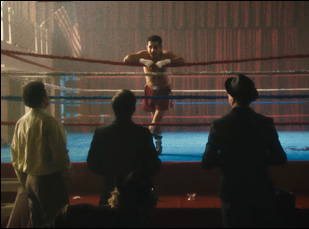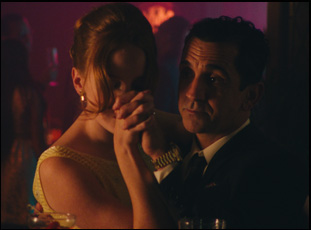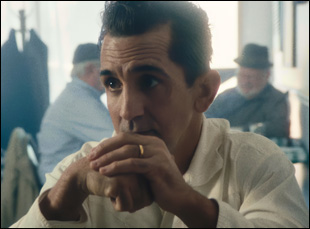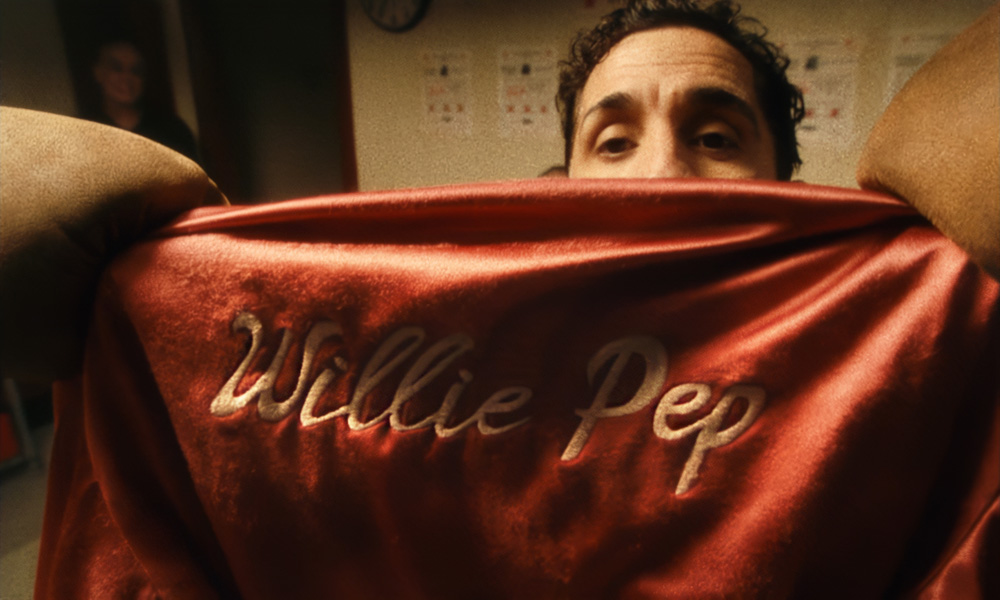At one point in “The Featherweight,” Willie Pep (James Madio) is asked to recall his most formidable foe over a long career in boxing and what comes to mind isn’t another boxer, but one of his ex-wives. Pep, born Guglielmo Papaleo, could always be counted on for a good quote, as punchy outside the ring as he was in it, but the wisecrack was telling when he clearly feared no opponent he faced with gloves on, losing only 11 times from 1942 to 1950 when 229 others hit the mat in front of him. Yet he was nowhere near as assured when the gloves came off and had to deal with his day-to-day life. His stamina, which more than made up for a lack of strength and size in title fights, would come to be a liability when faced with figuring out what to do with his time after boxing, making Robert Kolodny’s first feature fascinating when the fight isn’t where you’d think it would be.
A longtime collaborator of “Procession” director Robert Greene and “Pavements” director Alex Ross Perry as a cinematographer, Kolodny’s playful directorial debut unfolds as a faux documentary made at the time of Pep downshifting into a routine of using his local celebrity status in Hartford, Connecticut to host dinners with a feisty younger wife Linda (Ruby Wolf) on his arm with the hope of making a soft landing into retirement. Pep might not have been high-profile enough to get the Maysles brothers to come and film him, but he does get the next best thing in the Zupan brothers (largely existing off-screen), who are clearly in tune with their colleagues at the time in the mid-1960s, observing a life that their subject may not find all that interesting as he signs autographs at conventions and can be mildly jealous of his wife booking bit parts on TV procedurals as the spotlight starts to pull away from him. However, it’s more riveting to an outsider when everything Pep learned as a practitioner of the sweet science starts working against him when he has to settle in for the long haul, unable to do what he loves the most when he’s aged out, but struggling to find a passion for much else.
“The Featherweight” may be especially fun for cinephiles when Kolodny recruits his own brother Adam, also a cinematographer, to channel the direct cinema of Maysles, D.A. Pennebaker and Frederick Wiseman and as a throwback to another era, it has a revolutionary electricity about it as it had in its own time, but Madio is infectiously charismatic as the former boxer who can’t be kept down for too long and the film has a stacked supporting cast including Stephen Lang as Pep’s longtime trainer, Ron Livingston as his put-upon agent and Keir Gilchrist as his ne’r do well son that keep things lively. (Still, in her first major role, Wolf’s aspiring actress may be the film’s major scene stealer.) A year after its celebrated run on the festival circuit began at the Venice Film Festival, “The Featherweight” begins finding its way into U.S. theaters this week and Kolodny spoke about scoring such a knockout his first time out and making the narrative film in the style of nonfiction not only for the final product, but in the unconventional process of it.

I had been working on a nonfiction boxing film in Bulgaria for about five years prior to reading the script for “The Featherweight.” Initially, Steve James of “Hoop Dreams” fame was attached to direct the film. Eventually, he had to bow out because he had different projects going on and he recommended Robert Greene, who’s a collaborator of mine. He had no interest in making a fiction film, but I shot on his last three films and he thought of me because I’ve always wanted to work in fiction narrative, so I read the script and connected with the writer Steve Loff. I already had this vested interest in boxing and a like actionable knowledge of working in that genre and milieu, so it just felt like a perfect fit.
Was the conceit of this being a faux documentary with the Zupan Brothers there from the start? I know the reference is to the Albert and David Maysles, but of course, you recruit your own brother Adam to shoot it, so it all seems like fate.
Yeah, when I read the script, it had a lot of sit-down interviews and that more the doc conceit and as Steve [Loff] and I developed it over the next four years before production, I started to try to weave in more of a feeling of direct cinema. I’m obsessed with this movement in film and the films of D.A. Pennebaker and the Maysles brothers and Frederick Wiseman. Then when we got closer to production and I decided that my brother Adam would be the cinematographer, it only felt natural to create these personas of the Zupan brothers, so we sat down in Brooklyn in a bar one night and wrote down fictional biographies of Herman and Murray Zupan. We adapted these personas that were not dissimilar to the Maysles brothers and tried to be characters, first and foremost, so that the actors on set could use us as scene partners because of this verite aesthetic. If there’s a glance at the camera, rather than allowing it to be simply performative, they could really look at us, address us [as these faux filmmakers]. James Madio as Willie Pep could be like, “Hey Herman, turn the camera off,” so I think that added another element of play that was exciting.
When you inhabit a style of filmmaking so thoroughly from another era, was it interesting to learn about the techniques of those filmmakers?
Oh yeah, Adam and I watched so many of these films and broke them down and looked at, where is D.A. Pennebaker in the room? Where is Al Maysles in the room? We developed a visual language so that on set we could look at one of our scenes and be like, “All right, we’re going to cover this how Al would cover it,” which is normally like in the corner of the room, he’s on a wide and getting coverage of what’s happening. Then when he feels like he has the scene, stays in that position, punches in and then just gets his close shots and pivots from character to character and gets reactions. after the scene’s over, he’ll move in and get some coverage of detail shots. And then in the edit, that is separated out and parsed into a narrative structure for the scene that makes sense. So on set for any given circumstance, I can be like, “All right, we’re going to do this one like Al or we’re going to do this one like D.A,” and that would like inform things and keep it like kinetic.
A lot of work has to go into actually setting up scenes to be able to do that, and as I understand it, you gave yourself to room to place the camera anywhere when you could light it for 360-degree filming. What was it like to create those environments?
There was like a duality to this. There’s over 50 locations in the film. A lot of them are interiors, but we had a few exteriors and in our exteriors, we are so confined to where the camera could look. If we moved a foot this way, we’d see a modern stop sign. If we move a foot this way, there’s an anachronistic building. So we were really locked in [the camera] for exteriors, which made me want the interiors to feel as free and open and organic as possible. Our production designer Sonia Foltarz and I conceived of this idea to dress everything in 360 and even to have all of the furnishings full of period appropriate props so a character could come over, open something up, take something out, and it would be able to be used in the scene. This also strongly affects the lighting and the grip of how we’re putting everything together. All of our lighting had to be done either with practicals or shooting through the windows so that the camera and characters could move around and see anywhere in the space. But the actors, I think, really loved this. We worked these 30-minute periods of improvisation for every single scene into the schedule of the day, and a lot of that made its way into the film and informed this ephemeral feeling of nonfiction cinema.

It was wonderful. I come from a documentary background and actors always seemed like these like rare, beautiful creatures to me, but to actually get to work with actors was the most exciting part of the job on this because they’re just other craftspeople that really are longing to tell the same story that you’re telling. Because of the conceit of a faux documentary, I feel like I was able to communicate to them directly in a way that you’re not normally afforded and I became like a scene partner and we would conduct these interviews. A few of them did wind up in the film and it helped build the characters and the perceived relationship with the fictional film team within the film. It was a wonderful exercise, and partially inspired in a way by Cassavetes style of filming, [which is] well, let’s just go down this tangent and see where we wind up and maybe that will inform something and we’ll be able to round back.
It’s such a great showcase for James Madio as Willie Pep. What was it like working with him?
It was incredible. James was born to play this role, and I’m partial of course, but I think it is the performance that will define his career. He really put 110% of himself into this. He researched Willie Pep so diligently. He trained and transformed physically. He was coming up to Hartford before we even began pre-production and just renting a house and running around, embodying what Pep’s day-to-day life is, so working with him was a dream.
What was it like in general being up in Hartford where you’re in the same neighborhood where Willie Pep lived?
It was essential to making the film. So many of the locations are real locations from Willie’s life. The exterior of the house is the real house that Willie and Linda lived in at this time and we would go all over the place and meet people that [said], “Oh, I knew Willie Pep” and they would give us a story. At the beginning of the film, there’s this scene where we’re in the Italian American Social Club and there’s a guy making an espresso who says, “Oh, Willie’s real name is Guillermo Pappaleo and it means…” This is actually Willie Pep’s ex-barber and this is just a story that he started telling us, so we’re like, “Put this man in a period jacket and roll the camera.” There were many instances of this where we were able to just really feel the presence and the spirit of Willie Pep and Hartford, Connecticut really looks at him as a hometown hero, so to be able to shine a spotlight on him and shine a spotlight on that city, it felt really organic and right.

Our shooting ratio was really high, so we were able to more or less edit this like a documentary. There’s a lot of stuff that didn’t make it into the film and there was a lot of restructuring. For my money, Robert Greene has the best documentary instincts in the game right now. He’s an incredible filmmaker and director and just the best editor, so I felt very privileged to be able to work with him because we were really scrutinizing every cut and he was challenging me to have a justification. Why should the procession of one image lead to the next? This became part of our daily practice in considering and conceiving of how the scenes would flow and this idea of being able to restructure and have that kind of fluidity and freedom allowed the film to be a lot more incisive and a lot more ephemeral. There’s these moments in documentary and then specifically in the direct cinema movement that feel like shocking elisions of “Why would this happen?” Especially in Frederick Wiseman’s films — that organic spur of the moment feeling that communicates this directness like, “This is the human experience in witnessing it, not some kind of like vague facsimile of what it is, but the real genuine article.” Robert’s editing really pushed us into that in an actionable way.
When it’s your first feature as a director, what’s it like getting to this part of putting it out into the world?
Finishing any film and getting to this point is honestly a miracle. It’s so much work, and it’s so hard that I have such a deep respect for any filmmaker or team of filmmakers that get to this point. I’m just in awe right now of my producers and my actors and all of my collaborators that they’ve been able to hold the space and share this dream. And I’m excited for audiences to be able to see the film. This is the kind of film that I really love and the kind of film that I hope to continue making for my career and I hope people learn a little bit about Willie Pep and feel something.
“The Featherweight” opens on September 20th in New York at the Quad Cinema and in theaters across Connecticut and September 27th in Los Angeles at the Monica Film Center.




